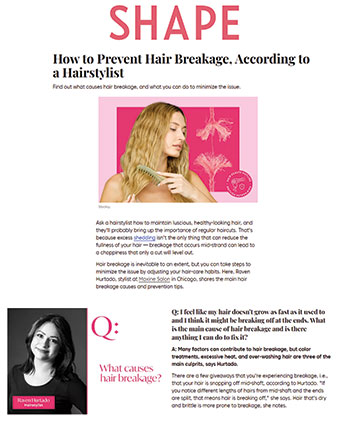Shape December 1, 2022
SHAPE
Beauty
How to Prevent Hair Breakage, According to a Hairstylist
Find out what causes hair breakage, and what you can do to minimize the issue.
Ask a hairstylist how to maintain luscious, healthy-looking hair, and they'll probably bring up the importance of regular haircuts. That's because excess shedding isn't the only thing that can reduce the fullness of your hair — breakage that occurs mid-strand can lead to a choppiness that only a cut will level out.
Hair breakage is inevitable to an extent, but you can take steps to minimize the issue by adjusting your hair-care habits. Here, Raven Hurtado, stylist at Maxine Salon in Chicago, shares the main hair breakage causes and prevention tips.
Q: I feel like my hair doesn't grow as fast as it used to and I think it might be breaking off at the ends. What is the main cause of hair breakage and is there anything I can do to fix it?
A: Many factors can contribute to hair breakage, but color treatments, excessive heat, and over-washing hair are three of the main culprits, says Hurtado.
There are a few giveaways that you're experiencing breakage, i.e., that your hair is snapping off mid-shaft, according to Hurtado. "If you notice different lengths of hairs from mid-shaft and the ends are split, that means hair is breaking off," she says. Hair that's dry and brittle is more prone to breakage, she notes.
The Main Cause of Hair Breakage
As mentioned, hair breakage has many possible causes, from being styled in with tight elastics to aggressive towel drying. But coloring your hair, frequently using hot tools, and over-washing seem to be the three main causes for concern, according to Hurtado.
"If you’re over-coloring your hair, the chemicals could be damaging your hair, causing it to become so brittle that eventually the hair starts to break off," explains Hurtado. Color treatments — especially those with permanent dye — often incorporate ammonia or peroxide, chemicals that can leave hair more prone to damage, as Shape previously reported. Ammonia raises the pH of hair and causes its cuticle (the outermost layer) to swell, putting hair in a more vulnerable state. Hydrogen peroxide causes oxidative damage that results in protein loss, which can also weaken strands.
As for hot tools, used in excess at high temperature settings, they can "burn the hair, which will cause split dry ends or cause the hair to break off mid-shaft," says Hurtado.
Finally, over-washing your hair can strip your scalp of its natural oil, leading to moisture loss, points out Hurtado. "That makes the hair dry and [more prone to] snapping in half." (On that note, here's exactly how often to wash your hair, depending on your hair type.)
How to Stop Hair Breakage from Getting Out of Hand
Given the info above, you've probably gathered that the best way to prevent hair breakage is to avoid color treatments and hot tools completely. But if you'd never swear off sleek blowouts or the new-me feeling of a fresh color, you can still take other steps to limit hair breakage. Moisturizing your hair to prevent dryness will become extra important, so consider adding a leave-in conditioner to your routine, suggests Hurtado. If you opt to use hot tools, try to keep them on the low or medium heat setting, she advises.
Also worth noting, hair is at its most fragile state (i.e., is most prone to breakage) when it's wet, as Shape previously reported. With that in mind, "another way to prevent breakage is [to avoid sleeping] with wet hair," says Hurtado. "Make sure it’s fully dry especially if you’re using a cotton pillowcase." Ideally, you'll switch to a silk pillowcase, which will be less likely to cause friction, and by extension, breakage, says Hurtado.
Sadly, there's no hair breakage treatment that reattaches fragments of your hair once they've snapped off. But keeping your hair moisturized, avoiding high heat settings, and handling your strands with care when wet can keep hair breakage to a minimum.

